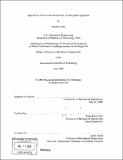| dc.contributor.advisor | Jung-Hong Chun. | en_US |
| dc.contributor.author | Sohn, Munhee, 1981- | en_US |
| dc.contributor.other | Massachusetts Institute of Technology. Dept. of Mechanical Engineering. | en_US |
| dc.date.accessioned | 2007-01-10T16:54:39Z | |
| dc.date.available | 2007-01-10T16:54:39Z | |
| dc.date.copyright | 2006 | en_US |
| dc.date.issued | 2006 | en_US |
| dc.identifier.uri | http://hdl.handle.net/1721.1/35641 | |
| dc.description | Thesis (S.M.)--Massachusetts Institute of Technology, Dept. of Mechanical Engineering, 2006. | en_US |
| dc.description | Includes bibliographical references (p. 90-91). | en_US |
| dc.description.abstract | As mobile devices advance to 3G and beyond, there will be a pressing need for increased power to drive these devices, which the current batteries cannot provide. The direct methanol fuel cell has been identified as a promising candidate to provide power to future mobile devices. However, commercialization of mobile devices containing fuel cells has been difficult due to several factors, including inefficiencies in the fuel cell, its large size, and difficulties of integration into the device. An Axiomatic approach was used to identify the key problems that prevent commercialization, along with identifying possible solutions for these problems. These possible solutions were investigated for use in developing a fuel cell for mobile devices of high performance, small size, and integrated hybrid circuitry. To construct a high performance fuel cell, several experiments varying the methanol flow rate, oxygen and methanol concentration, and cathode gas diffusion layer (GDL) were performed on two standard membrane electrode assemblies (MEA). In addition, an MEA was modified using polyvinyl alcohol (PVA) to test its effect on decreasing methanol crossover for improved fuel cell performance. | en_US |
| dc.description.abstract | (cont.) In order to decrease the overall size of the fuel cell, a passive fuel cell design was implemented. A potentionstat was used to measure voltage and current and these measurements were used to plot current and power density curves. These results showed that increasing oxygen concentration improved performance, whereas increasing methanol concentration decreased performance due to methanol crossover effects. The effects of the changes of methanol flow rates were negligible and using a plain carbon cloth was just as efficient as using carbon paper coated with a micropourous layer. The performance of the prefabricated MEAs was much lower than that of the experimentally fabricated MEAs, but followed normal performance curve trends. Furthermore, the modified PVA/Nafion membrane showed improvement in preventing methanol crossover although it had decreased proton conductance. Finally, a fuel cell - capacitor hybrid circuit demo was designed and demonstrated. | en_US |
| dc.description.statementofresponsibility | by Munhee Sohn. | en_US |
| dc.format.extent | 91 p. | en_US |
| dc.format.extent | 4875933 bytes | |
| dc.format.extent | 4879692 bytes | |
| dc.format.mimetype | application/pdf | |
| dc.format.mimetype | application/pdf | |
| dc.language.iso | eng | en_US |
| dc.publisher | Massachusetts Institute of Technology | en_US |
| dc.rights | M.I.T. theses are protected by copyright. They may be viewed from this source for any purpose, but reproduction or distribution in any format is prohibited without written permission. See provided URL for inquiries about permission. | en_US |
| dc.rights.uri | http://dspace.mit.edu/handle/1721.1/7582 | |
| dc.subject | Mechanical Engineering. | en_US |
| dc.title | Hybrid fuel cell for mobile devices : an integrated approach | en_US |
| dc.type | Thesis | en_US |
| dc.description.degree | S.M. | en_US |
| dc.contributor.department | Massachusetts Institute of Technology. Department of Mechanical Engineering | |
| dc.identifier.oclc | 76703105 | en_US |
